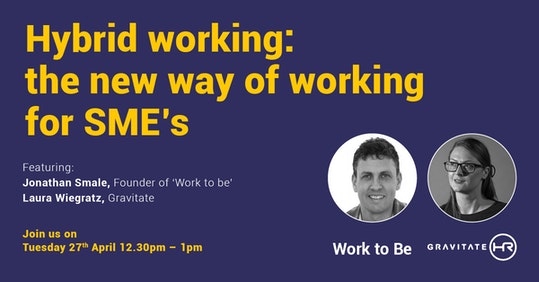Laura and Margery were delighted to be joined by Jonathan Smale, Founder of ‘Work to Be’ in our recent webinar on 27 th April 2021.
Jonathan has been helping organisations adopt more agile working practices for a number of years now and carried out a lot of research into the impact of Covid, lockdown and future ways of working.
Working from home is not a new concept, however over the past year, working from home has taken on a whole new meaning.
For many of us, working from home has not been through choice, we have been at home because of the pandemic – trying to balance our work and manage our home lives and we have all had different experiences of ‘home working’.
The pandemic has been a catalyst for cultural change but we have shown that we are very adaptable creatures and we challenged the status quo of working from home pretty quickly.
As we transition out of lockdown, we are looking for more flexibility and many organisations are now taking this on board and looking at hybrid working practices.
Jonathan shared some key considerations for implementing a hybrid working model. The first point Jonathan raised was keep it simple.
We have a natural tendency to control and predict things, however, this can lead to over complication and we may end up with a different set of restrictive practices. The more procedures we have in place, the more prescriptive and less adaptable and flexible your model becomes.
Before any planning takes place, it is important to reflect on what we have learnt throughout the year and involve staff in the planning process.
Jonathan talked about John Adair’s, Action Centered Leadership model, although an old model now, it applies well to hybrid working. The model talks about balancing three needs;
-
- Organisational need (driven by purpose, values and principles)
- Individual need (driven by personal preference and circumstances)
- Team need (driven by customer needs and outcomes)
1. Organisation – this is driven by purpose and values and is a great starting point for producing simple principles to give people guidelines on how to manage their own model.
2. Team – this takes into account customers and output. As each team is different, useful to have an overarching framework but devolve responsibility and accountability to teams. Some roles led themselves better to remote or hybrid working, others don’t.
3. Individual – Everyone has different expectations and needs, it is important to listen to staff.
It is important to ensure an equal balance however, and Jonathan talked about some of the implications of not achieving this balance.

In summary, if these needs are balanced equally, it is a very useful framework and starting point before working out the detail.
Another important consideration is how the use of office space is key to successful hybrid working. Organisations may need to look at reinventing office space and purpose so it better reflects culture, brand and purpose and take on more of an activity based approach.
This proved to be a very useful and informative session, it is a really exciting time and we have an opportunity to embrace a new way of working, to reinvent our workspaces and become more flexible and adaptable.
This is a huge subject area and Jonathan also touched upon Leadership, Mental Health and potential contractual obligations. Gravitate will be exploring these areas over the coming months.
if you would like further advice or guidance around developing your hybrid models, please get in touch with laura@gravitatehr.co.uk
A recording of the webinar can be found here
